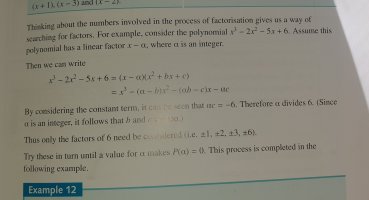I am working through a chapter on factorising polynomials and I don't understand one part of an example. The sentence i don't understand is this:
"By considering the constant term, it can be seen that -@c = 6. Therefore @ divides 6 ( since @ is an integer it follows that b and c are too.)."
Below is the part of the textbook I got the sentence from. I don't understand what the books means that "@ Divides 6" and that it follows that b and c are integers because @ is an integer.
All help appreciated
"By considering the constant term, it can be seen that -@c = 6. Therefore @ divides 6 ( since @ is an integer it follows that b and c are too.)."
Below is the part of the textbook I got the sentence from. I don't understand what the books means that "@ Divides 6" and that it follows that b and c are integers because @ is an integer.
All help appreciated

